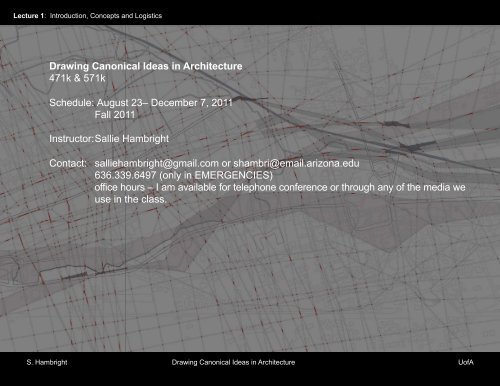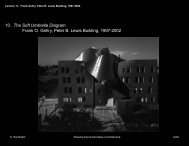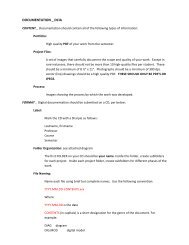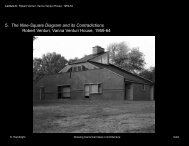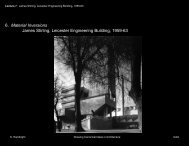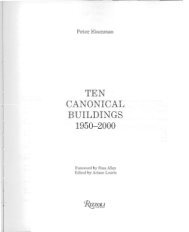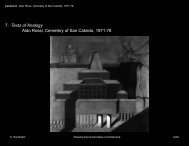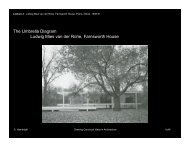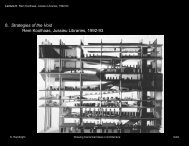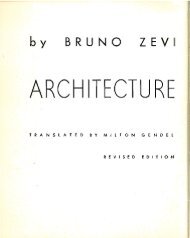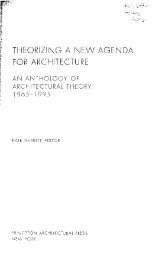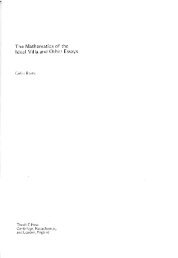Intro - Drawing Canonical Ideas in Architecture
Intro - Drawing Canonical Ideas in Architecture
Intro - Drawing Canonical Ideas in Architecture
- No tags were found...
Create successful ePaper yourself
Turn your PDF publications into a flip-book with our unique Google optimized e-Paper software.
Lecture 1: <strong>Intro</strong>duction, Concepts and Logistics<strong>Draw<strong>in</strong>g</strong> <strong>Canonical</strong> <strong>Ideas</strong> <strong>in</strong> <strong>Architecture</strong>471k & 571kSchedule: August 23– December 7, 2011Fall 2011Instructor: Sallie HambrightContact: salliehambright@gmail.com or shambri@email.arizona.edu636.339.6497 (only <strong>in</strong> EMERGENCIES)office hours – I am available for telephone conference or through any of the media weuse <strong>in</strong> the class.S. Hambright <strong>Draw<strong>in</strong>g</strong> <strong>Canonical</strong> <strong>Ideas</strong> <strong>in</strong> <strong>Architecture</strong> UofA
Lecture 1: <strong>Intro</strong>duction, Concepts and LogisticsThis sem<strong>in</strong>ar is a History/Theory course that attempts to uncover ideas <strong>in</strong> build<strong>in</strong>gs us<strong>in</strong>g anarchitect’s medium: draw<strong>in</strong>g. <strong>Draw<strong>in</strong>g</strong> <strong>Canonical</strong> <strong>Ideas</strong> <strong>in</strong> <strong>Architecture</strong> will not teach studentshow to draw but how to draw what is thought. Us<strong>in</strong>g Peter Eisenman’s “Ten <strong>Canonical</strong>Build<strong>in</strong>gs” as a framework of learn<strong>in</strong>g how to understand and see architecture, students willlearn the relationships between analysis and design. Eisenman produced “Ten <strong>Canonical</strong>Build<strong>in</strong>gs.” This sem<strong>in</strong>ar will attempt to discover if Eisenman himself has a canonical work.Each student will choose a build<strong>in</strong>g designed by Peter Eisenman. They will analyze thebuild<strong>in</strong>g throughout the semester. In the end, each student, will have composed a chapter oftheir own. Students will produce draw<strong>in</strong>gs, descriptions of their analysis, and learn to critiquedraw<strong>in</strong>gs from an analytical approach. This course attempts to teach through see<strong>in</strong>g,draw<strong>in</strong>g what is seen, and writ<strong>in</strong>g/describ<strong>in</strong>g what is drawn. These are essential skills tobecom<strong>in</strong>g an architect.Please review the syllabus. It is located on D2L and the blog.S. Hambright <strong>Draw<strong>in</strong>g</strong> <strong>Canonical</strong> <strong>Ideas</strong> <strong>in</strong> <strong>Architecture</strong> UofA
Lecture 1: <strong>Intro</strong>duction, Concepts and LogisticsTh<strong>in</strong>gs you need to do IMMEDIATELY:• Familiarize yourself with D2L• Sign up for Wordpress and familiarize yourself with the blog platform – send me yourusername and email ASAP, so I can give you edit<strong>in</strong>g abilities. UofA emails please. The blogaddress is http://draw<strong>in</strong>gcanonicalideas<strong>in</strong>architecture.wordpress.com/ .• Sign up to follow me on Twitter : salliehambright• Purchase “Ten <strong>Canonical</strong> Build<strong>in</strong>gs” – This book is on back order. I am work<strong>in</strong>g to provide youwith the materials• Review the Google Calendar which can be found on the blog, DCIA – Fall 2011• Assignments 1 & 2 are given today. You can f<strong>in</strong>d them on D2L and the blog. Start Assignment2 today!S. Hambright <strong>Draw<strong>in</strong>g</strong> <strong>Canonical</strong> <strong>Ideas</strong> <strong>in</strong> <strong>Architecture</strong> UofA
Lecture 1: <strong>Intro</strong>duction, Concepts and LogisticsTeach<strong>in</strong>g Platforms:D2L: I will post all course documents to D2L <strong>in</strong>clud<strong>in</strong>g syllabi, assignments, grades, lectures.This is where you will formally post your Assignments, Read<strong>in</strong>g Responses, and Build<strong>in</strong>gExamples. COMING SOON!!!!Blog: Our blog address is http://draw<strong>in</strong>gcanonicalideas<strong>in</strong>architecture.wordpress.com/ . Please,sign up for Wordpress and use your University of Arizona email. Email me your username andemail ASAP. We will use the blog for our Blog Responses, shar<strong>in</strong>g our process and completedassignments, Peer critique, and class discussions. Please do not post HUGE files to the blog.Keep it at about 700KB per image.Google Calendar: I have created a Google Calendar, DCIA – Summer 2011. You can reach itfrom the blog. All due dates are listed here. If there need to be updates to the calendar, I willmake them here.Twitter: Please sign up to follow me on Twitter, salliehambright. I will make importantannouncements via my Twitter account. You can also see my Twitter comments on the blogand go to my Twitter page from the blog.Ellum<strong>in</strong>ate: We will only use Ellum<strong>in</strong>ate, live video sessions, if need be. I will keep you posted.If we use this platform, it will only be for a couple of sessions.S. Hambright <strong>Draw<strong>in</strong>g</strong> <strong>Canonical</strong> <strong>Ideas</strong> <strong>in</strong> <strong>Architecture</strong> UofA
Lecture 1: <strong>Intro</strong>duction, Concepts and LogisticsGraded components of the course will be:Assignments 1-7: These assignments will be draw<strong>in</strong>g analyses based on different aspects of architecture : space, tectonics, context,program, and circulation. The students will be expected to not only depict what is physically exist<strong>in</strong>g but what is thought.<strong>Canonical</strong> Chapter: Graduate Students – Graduate Students will write a 3200-3500 word research paper (Chapter 11) us<strong>in</strong>g assignments3-7, any additional draw<strong>in</strong>g analysis, and course read<strong>in</strong>gs to establish if their respective build<strong>in</strong>gs are canonical. You must submit a f<strong>in</strong>al,hard copy, to me by mail that I will keep.Portfolio: Undergraduate Students – Undergraduate Students will compose their previous analyses <strong>in</strong>to a portfolio that clearly expressesthe ideas discovered dur<strong>in</strong>g the semester. While this is not a research paper, the portfolio should tell a complete story of the semester longanalysis. Students may also be required to develop the analysis further at the discretion of the professor. You must submit a f<strong>in</strong>al, hardcopy, to me by mail that I will keep.Read<strong>in</strong>g Response: Graduate Students – Two page read<strong>in</strong>g responses will be required for each of the chapters of “Ten <strong>Canonical</strong>Build<strong>in</strong>gs” on the respective lecture day. For the response, the students will choose a piece of architecture that also exemplifies the ideaspresented <strong>in</strong> the read<strong>in</strong>g. It is also permissible to choose a build<strong>in</strong>g that is contrasted with the ideas <strong>in</strong> the read<strong>in</strong>gs. The submission<strong>in</strong>cludes one written page and one page of images of the chosen build<strong>in</strong>g. The responses are not f<strong>in</strong>ished papers but a reaction to whathas been read.Build<strong>in</strong>g Example: Undergraduate Students – Each student will compose a sheet show<strong>in</strong>g an image of an exist<strong>in</strong>g build<strong>in</strong>g they th<strong>in</strong>kuses the same ideas as the build<strong>in</strong>g presented <strong>in</strong> Eisenman’s text. The student should write a short paragraph, 3-4 sentences, expla<strong>in</strong><strong>in</strong>ghow the idea is legible <strong>in</strong> the image.Blog Responses: In the PowerPo<strong>in</strong>t’s I post each week on the respective chapters, I will ask questions and pose ideas for thought. Youshould make two (2) comments on these or other aspects of the chapters. Once, these are posted you will respond to three (3) of yourclassmates’ comments. Note that your comments are due on Wednesday of each week and your responses to others comments is due nolater than Friday of each week. This is to ensure that we will have a vibrant onl<strong>in</strong>e discussion.Peer Critique: You are required to comment on two (2) of your classmates’ assignment each time an assignment is due. You are to giveconstructive criticism, make suggestions, make l<strong>in</strong>ks with your own analysis, etc… Please note that your critiques are due by Wednesdayof the correspond<strong>in</strong>g week.Documentation: Each student will submit proper documentation at the end of the semester. There will be specific guidel<strong>in</strong>es for thesubmission. F<strong>in</strong>al copies of the <strong>Canonical</strong> Chapter and the Portfolio will also be kept and these should be turned <strong>in</strong> by the F<strong>in</strong>al Submittaldate.S. Hambright <strong>Draw<strong>in</strong>g</strong> <strong>Canonical</strong> <strong>Ideas</strong> <strong>in</strong> <strong>Architecture</strong> UofA
Lecture 1: <strong>Intro</strong>duction, Concepts and LogisticsGrad<strong>in</strong>g: GraduateAssignments 1-7 35%<strong>Canonical</strong> Chapter 30%Read<strong>in</strong>g Responses 10%Blog Responses 10%Peer Critique 10%Documentation 5%Total 100%UndergraduateAssignments 1-7 35%Portfolio 30%Build<strong>in</strong>g Example 10%Blog Responses 10%Peer Critique 10%Documentation 5%Total 100%Grad<strong>in</strong>g Scale:A (90-100): Excellence <strong>in</strong> most areas of evaluation, high competence <strong>in</strong> others.B (80-89): High competence <strong>in</strong> most areas of evaluation, competence <strong>in</strong> others.C (70-79): Fulfilled all course requirements with competence. Competence is the answer<strong>in</strong>g of all requirements; adequate ability,capacity; sufficient for the purpose.D (60-69): (Undergraduates only) Less than competent work <strong>in</strong> one or more areas of evaluation. One or more requirements lack<strong>in</strong>gand/or sub-standard quality.F (below 59): (Undergraduates only) Substantially <strong>in</strong>complete work and/or work of an unsatisfactory quality.F (below 69): (Graduates only) Substantially <strong>in</strong>complete work and/or work of an unsatisfactory quality.Late Work: In order to develop good professional habits, work that is late will be marked one or more grades lower than similar workcompleted on time, depend<strong>in</strong>g on the degree of lateness.Incomplete: Work left <strong>in</strong>complete at the end of the semester due to circumstances beyond the student’s control.S. Hambright <strong>Draw<strong>in</strong>g</strong> <strong>Canonical</strong> <strong>Ideas</strong> <strong>in</strong> <strong>Architecture</strong> UofA
Lecture 1: <strong>Intro</strong>duction, Concepts and LogisticsThis course owes its creation to Col<strong>in</strong> Rowe’s analysis/comparison of a Corbusian andPalladian villa. This analysis shows that there are hidden structures <strong>in</strong> architecture that canl<strong>in</strong>k seem<strong>in</strong>gly disparate build<strong>in</strong>gs. These two build<strong>in</strong>gs could not ‘look’ more different.S. Hambright <strong>Draw<strong>in</strong>g</strong> <strong>Canonical</strong> <strong>Ideas</strong> <strong>in</strong> <strong>Architecture</strong> UofA
Lecture 1: <strong>Intro</strong>duction, Concepts and LogisticsThrough an analysis of the plans, you can see how Rowe discovered similar underly<strong>in</strong>gproportions and spatial organizations. This is similar to what we will do this semester. We willbe discover<strong>in</strong>g the hidden or latent ideas <strong>in</strong> the forms of Eisenman’s own work. We are notconcerned with the way the build<strong>in</strong>g looks optically (what we see with the eyes), but what wecan see visually (what we see with the m<strong>in</strong>d).S. Hambright <strong>Draw<strong>in</strong>g</strong> <strong>Canonical</strong> <strong>Ideas</strong> <strong>in</strong> <strong>Architecture</strong> UofA
Lecture 1: <strong>Intro</strong>duction, Concepts and LogisticsCarlo Scarpa, exist<strong>in</strong>g build<strong>in</strong>gNotation and Spatial FormMovementProgram and Function Tectonics and Structure DetailExamples of a student’s work, Sarah L<strong>in</strong>, <strong>in</strong> a similar class. She was analyz<strong>in</strong>g a CarloScarpa build<strong>in</strong>g, the one <strong>in</strong> the upper left image.S. Hambright <strong>Draw<strong>in</strong>g</strong> <strong>Canonical</strong> <strong>Ideas</strong> <strong>in</strong> <strong>Architecture</strong> UofA
Lecture 1: <strong>Intro</strong>duction, Concepts and LogisticsI’m look<strong>in</strong>g forward to a great semester!If you have any questions, please email me, post on the blog, post on Twitter, or any ofthe other ways I have set up for us to communicate.<strong>Draw<strong>in</strong>g</strong> <strong>Canonical</strong> <strong>Ideas</strong> <strong>in</strong> <strong>Architecture</strong>471k & 571kSchedule: August 22 – December 7, 2011Fall 2011Instructor: Sallie HambrightContact: salliehambright@gmail.com or shambri@email.arizona.edu636.339.6497 (only <strong>in</strong> EMERGENCIES)office hours – I am available for telephone conference or through any of the media weuse <strong>in</strong> the class.S. Hambright <strong>Draw<strong>in</strong>g</strong> <strong>Canonical</strong> <strong>Ideas</strong> <strong>in</strong> <strong>Architecture</strong> UofA


